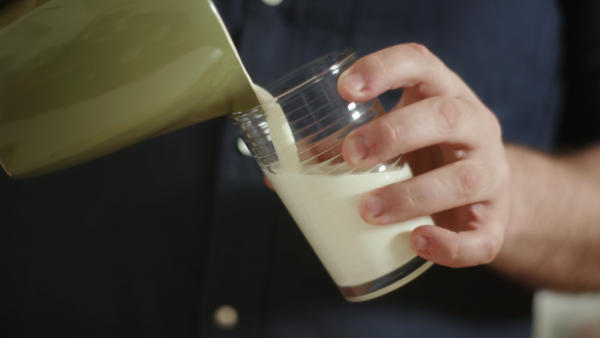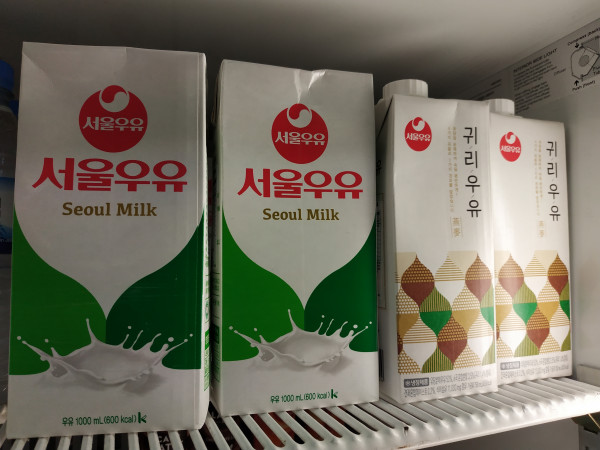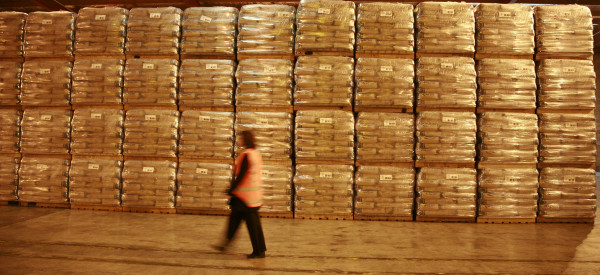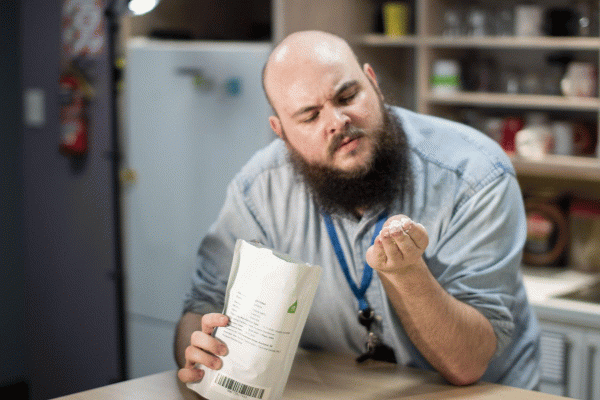We all know a huge chunk of our country and economy is dedicated to producing and exporting dairy. But not many people know that we also import a lot of dairy. If we’re making it here, why do we need to buy it from overseas? Re: journalist Baz Macdonald got sucked down the dairy rabbit hole trying to find the answer.
This article is part of Milk and Money, a documentary and article series about the true cost of dairy in Aotearoa. You can watch it now on Re: and TVNZ OnDemand.
Sitting around a dinner table at a dairy farm in Waikato last year, I was asked a very strange question.
“Do you think all the milk we drink is from New Zealand? Because I heard the budget brands bring milk in from countries like Bulgaria for cheap and mix it with ours.”
I had spent almost a year researching the dairy industry at this point, and had been on the road for months meeting with dairy farmers and industry experts for a documentary on New Zealand dairy, Milk and Money, which you can and should check out here.
I thought I had heard it all. But this was a new one.
I started asking around about this rumour, and many others had heard it too. Turns out it is quite a widespread - if not openly discussed - bit of gossip in the industry.
But is it true? To find out, I dove into one of our country’s most confusing bureaucracies - the Customs database.

Getting the answers from Customs
It turns out it’s not just a simple case of asking Customs whether we import milk. Because Customs is a government department, all of the information about what we import is technically able to be accessed by the public, but it’s spread across thousands of spreadsheets.
All products brought into New Zealand are categorised by a complex system of codes and descriptions called tariffs. To give you an example of how difficult it can be to figure out what we are actually importing, here is the description of one of the dairy product categories:
Products of milk not whey concentrated or sweetened not liquid or semi-solid
What am I supposed to do with that?
With a bit of digging I was able to figure out the codes for fresh milk and the truth was quickly revealed.
In 2019, the most recent year the data was available, we imported 1,792 litres of fresh milk.
To put that into perspective, New Zealand consumes 400 million litres of milk every year - that’s 80 litres per person.
So, in 2019, 0.000448 percent of the milk drunk in New Zealand was imported.
Curiously though, most of that imported milk came from South Korea. Turns out that some Korean supermarkets in Auckland import it. I had a lovely conversation with the head of the Korean-New Zealand cultural association, Diane Lee.
She says Korean-New Zealanders occasionally buy it either for the nostalgic taste, or for specific Korean recipes. Then she popped out to some Korean markets to take some pictures of milk for me. What a lovely woman.

Regardless, the myth about our imported fresh milk was busted. You can trust that any milk you buy in New Zealand is produced here (unless you’re at a Korean supermarket).
But...
That didn’t mean we weren’t importing dairy.
We don’t import much fresh milk, but we are importing huge amounts of other types of dairy
Through my Customs deepdive, I found that we import millions of kilograms of dairy products a year. In 2019 alone, we imported 62 million kilograms of dairy.
Some of this is understandable. For instance, we brought in relatively small amounts of artisanal cheeses: 114,000 kg of Dutch gouda, or 203,000 kg of Danish blue-vein. Bloody delish.
There were also imports of dairy products we don’t manufacture in New Zealand, like 2500 kg of condensed milk from Malaysia. (We used to make condensed milk here in New Zealand, but our market was too small so they shut down the plants.)
But these kinds of products were tiny percentages of what we are bringing in. That gouda and danish blue vein, for instance, is only 0.005 percent of the dairy we imported in 2019.
By and large, the dairy products we are importing are actually the same thing our dairy industry produces in huge quantities: dairy ingredients.
Despite the decades of adverts you have seen depicting our dairy’s industry’s output as a nice refreshing glass of milk, that is not actually where we make money.
The New Zealand dairy industry largely produces powdered dairy ingredients that are used in processed foods or products like infant formula. Of our 2020 dairy exports, less than five percent was liquid milk, while two-thirds was some kind of powdered milk - mostly whole milk powder.
But the Customs data showed it is these same dairy ingredients we are bringing in. The three largest products imported are whey, lactose, and skim milk powder.
Granted, the quantities of these products pale in comparison to the amount we are exporting. In 2020, New Zealand exported nearly six billion kilograms of dairy products. The 62 million kilograms we imported last year is only one percent of that amount.
On one hand, you could say, “Who cares if we are importing dairy when it is such a small amount compared to our exports?” But another way to see it is, “Why the hell are we importing the equivalent weight of 62 thousand cars in dairy products every year when we already produce six million cars’ worth?”

Pallets of milk powder at a Fonterra plant
Who is importing all of this dairy, and what the hell is it being used for?
Unfortunately, Customs is not able to tell us who is importing what product because it is commercially sensitive information. This makes it difficult to find out what these imported products are used for.
To help figure that out, I spoke to Massey University food technologist, and president of the New Zealand Institute of Food Science and Technology, Richard Archer. His career has been largely identifying the value of these dairy ingredients.
Take, for instance, whey. For most of us, whey is just what Little Miss Muffet ate as she sat on her tuffet.
But, for food manufacturers, whey is a yellow-ish liquid leftover after you’ve made cheese. For millennia, whey was an incredibly important part of the diet of many milk-drinking cultures - and for good reason, as it contains 99.9 percent of the individual nutrients in milk.
Whey in powdered form
But, as we began mass-producing foods like cheese, whey’s value became overlooked.
“That’s been my career,” Richard says. “When I started, whey was mostly going down drains and when I finished it was the most valuable material there is in the country.”
Whey is the dairy product we import the most of. Last year we imported 20 million kilograms of it, mostly from Germany, France and the United Kingdom.
But why?
Richard believes this whey is mostly being used in infant formula.
In the past five years, infant formula has become a much bigger part of the New Zealand dairy business. In 2019, we made 1.6 billion dollars from it - 10 percent of that year's dairy revenue.
When making infant formula, whey is an important supplement because of the different protein ratios in human and cow’s milk.
Obviously, a cow and a human are quite different, so we need different proteins to help us grow up. Cow’s milk has about three times more protein than human milk, but it is the wrong kind of protein.
Human milk protein is mostly whey, and the rest is another protein called casein. Whereas cow's milk is flipped, with mostly casein and a smaller amount of whey.
If our bodies were a house, our DNA would be the blueprints, and proteins the building materials. Eating proteins is like popping down to Bunnings to pick up the bricks, wood, and nails you need. Then little builders in your body use DNA as a guide for putting those materials together in the right order.
In the case of these proteins, it is like cow’s milk is heavy in bricks, and humans are made of wood. So, when making infant formula from cow's milk, extra whey is required to switch those ratios to make sure lil babies have all the wood they need to grow.

Re: journalist Baz Macdonald investigating the milk bi-product casein.
The strange world of lactose imports
After whey, the next-largest imported dairy product is listed under that bizarre description I shared earlier:
Products of milk not whey concentrated or sweetened not liquid or semi-solid
Richard believes this is lactose, a sugar in milk that is itself a byproduct of whey.
Welcome to the crazy world of milk ingredients, where we trade in byproducts of byproducts.
For most people, lactose is probably associated with the phrase lactose-intolerance, the most common form of milk allergy.
Lactose in powdered form
(As an aside, it might surprise you to know that a whopping 70 percent of the world’s population is some degree of lactose-intolerant, but different cultures have varying levels of intolerance. The allergy is lowest in countries with long histories of dairy agriculture - such as Europe where it averages at about a quarter of the population - and highest in places where dairy farms were less common - such as the Middle East and Asia where over two-thirds of people are lactose-intolerant.)
Cows produce varying levels of lactose depending on factors like diet, season, and where they are at in their pregnancy.
But despite these seasonal variations, consumers expect dairy products to contain the same levels of different components all year around. To do this, the industry standardises components like lactose, by taking out excess at some points in the season, and adding it in when it is below the standard level.
We import lactose and add it into our fresh milk to make up for those seasonal shortages.
But, you might be asking yourself, “Why don’t we just keep the excess lactose we make here and use it during these shortages?” Well, Richard says the lactose we produce is so good, it would almost be wasteful to use it for standardisation.
“New Zealand is very, very good at making some of the best lactose in the world, which is the basis of pretty much every pill. Every tablet, every pill, in the world is predominantly made from pharmaceutical grade lactose and New Zealand is one of the best suppliers in the world.”
This high value, it turns out, is at the heart of why we are importing dairy.
The answer is that we have gotten so good at making high-grade versions of these products that we have essentially priced ourselves out of using it in our products, and have to import cheaper versions instead.
“We make the best use of that raw material by exporting it for its highest price. And then when we need more, we buy it in [from overseas] for the lowest price.”
“Which is fantastic,” Richard says. “Unless you don't want lots of ships running around the world - which some people don't.”
Is this system genius or ridiculous?
The concern people have for all those ships running around the world is the environmental impact. Shipping tons of dairy materials back and forth across the world may make financial sense, but we need to include the environmental impact of that trade to the balance sheet.
Around 10 percent of global emissions come from freight, across trucks, rail and ships. In New Zealand, it is our second-biggest emitting sector, behind only dairy.
In our current dairy trade, the industry transports milk from 10,000 farms around New Zealand to processing factories, where it gets turned into these dairy components, which are then trucked or railed to a shipping port, then shipped across the world, where they will then get transported to another manufacturing plant.
The countries we are buying those same dairy components from have to go through the same steps to get their version back to us.
Think about all of that energy and transport, when logistically we could have cut out that entire process by simply using the components we produced here in the first place.
It is kind of like driving from Auckland to Invercargill for a bag of sugar because it’s much cheaper down there, instead of popping to your local supermarket.
Does this kind of trade still make sense if the environmental impact of this freight was added to the balance sheet?
In some cases it might, especially when components like lactose are used for entirely different purposes when we produce them at a certain quality - like pharmaceuticals. But, for other things it may not - such as whey, which we seem to be trading simply to get the best price.
Having gone down this dairy rabbit hole, I was blown away to discover how we have taken something relatively simple - milk - and somehow turned it into a complex global trading network of niche components. I keep asking myself - is this system genius or ridiculous?
It’s probably a bit of both.
There are genius aspects. You wouldn’t believe how long the list is of what dairy components end up as. Of course there are a million different food products, but there is even a wide range of non-food products, from buttons to chalk.
Over the past fifty years, the dairy industry has figured out every applicable use for milk, and has chased the avenues that will make the most money.
But, that is where things have gotten ridiculous. The global trade of these products has stepped over the line of finding the best applicable use for milk, and prioritised making the most money for it - regardless of if that makes logical sense.
Far out… when did milk get so damn complicated?